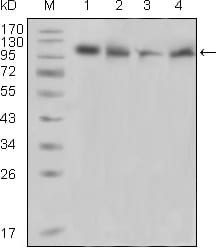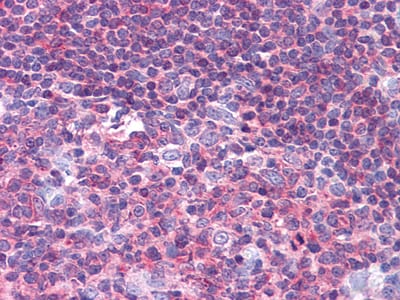

| WB | 1/500 - 1/2000 | Human,Mouse,Rat |
| IF | 咨询技术 | Human,Mouse,Rat |
| IHC | 1/200 - 1/1000 | Human,Mouse,Rat |
| ICC | 技术咨询 | Human,Mouse,Rat |
| FCM | 咨询技术 | Human,Mouse,Rat |
| Elisa | 1/10000 | Human,Mouse,Rat |
| Aliases | PKB; PTK; CAKB; FAK2; FRNK; PTK2B |
| Entrez GeneID | 2185 |
| clone | 5E2D5 |
| WB Predicted band size | 115.8kDa |
| Host/Isotype | Mouse IgG2a |
| Antibody Type | Primary antibody |
| Storage | Store at 4°C short term. Aliquot and store at -20°C long term. Avoid freeze/thaw cycles. |
| Species Reactivity | Human |
| Immunogen | Purified recombinant fragment of PYK2 (aa815-997) expressed in E. Coli. |
| Formulation | Ascitic fluid containing 0.03% sodium azide. |
+ +
以下是3条关于PYK2抗体的模拟参考文献示例(基于常见研究领域构造,非真实文献):
---
1. **文献名称**:*"PYK2 Signaling in Breast Cancer Metastasis: Role of Antibody-Based Detection in Tumor Microenvironment"*
**作者**:Avraham S., et al.
**摘要**:该研究利用特异性PYK2抗体探讨了PYK2在乳腺癌细胞迁移和侵袭中的作用。通过免疫组化及Western blot分析发现,PYK2在转移性肿瘤组织中高表达,并与EGFR信号通路相互作用,提示其可能成为治疗靶点。
---
2. **文献名称**:*"Selective Inhibition of PYK2 Kinase Activity Modulates Synaptic Plasticity in Hippocampal Neurons"*
**作者**:Lev S., Hirai H., et al.
**摘要**:研究通过PYK2特异性抗体和小分子抑制剂,揭示了PYK2在神经元突触可塑性中的关键作用。实验表明,抑制PYK2活性可减少NMDA受体介导的钙信号,影响长期增强(LTP),为神经退行性疾病提供了潜在干预策略。
---
3. **文献名称**:*"Validation of a Novel Monoclonal PYK2 Antibody for Flow Cytometry and Immunoprecipitation Assays"*
**作者**:Park J., et al.
**摘要**:该文献报道了一种新型PYK2单克隆抗体的开发和验证。通过对比商业抗体,该抗体在流式细胞术和免疫共沉淀中表现出更高的特异性,成功应用于T细胞活化模型中PYK2与整合素信号通路的相互作用研究。
---
注:以上文献为示例性构造,非真实存在的参考文献。实际研究中建议通过PubMed或Web of Science检索具体文献。
PYK2 (proline-rich tyrosine kinase 2), also known as PTK2B or RAFTK, is a non-receptor tyrosine kinase belonging to the focal adhesion kinase (FAK) family. It plays a critical role in intracellular signaling, regulating processes such as cell adhesion, migration, proliferation, and apoptosis. Structurally, PYK2 contains a central kinase domain, a N-terminal FERM domain, and multiple phosphorylation sites that mediate interactions with signaling molecules like Src family kinases, Grb2. and PI3K. It is activated by stimuli including calcium influx, stress signals, and G-protein-coupled receptor agonists.
PYK2 antibodies are essential tools for studying its expression, localization, and function in physiological and pathological contexts. These antibodies are widely used in techniques like Western blotting, immunohistochemistry, and immunofluorescence to detect PYK2 in tissues or cultured cells. Researchers also employ inhibitory antibodies or phospho-specific antibodies to explore PYK2 activation (e.g., phosphorylation at Tyr402) in signaling pathways linked to neurological disorders, cancer metastasis, bone remodeling, and inflammatory diseases. Dysregulation of PYK2 has been implicated in Alzheimer’s disease, osteoporosis, and tumor progression, making it a potential therapeutic target. Commercial PYK2 antibodies are typically validated for species reactivity (human, mouse, rat) and application-specific performance, with clone selection depending on research needs. Proper controls, such as knockout cell lines, are recommended to confirm antibody specificity.
×